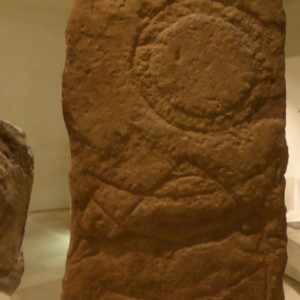After hearing a talk about pre Christian religious sites in Scotland I decided to revisit the exhibits of Early Man in the Museum of Edinburgh. Among the collection of artefacts are several standing stones including this red sandstone stone (changed into black and white for the MonoMonday challenge) which a farmer had discovered while ploughing his field in 1894 near Elgin in Moray.
Traditionally Pictish stones are found in parts of northern and eastern Scotland where there are many stones with Pictish symbols some of which depict animals which were associated as being magical or powerful. Others have symbols representing objects, weapons or valued personal items but no one knows exactly what they mean. As beliefs changed and Christianity was gradually adopted they became less important and the stones were carved with Christian symbols with the cross eventually replacing them.
The stone is one of the later stones of the period and dates from about 700 AD and has a goose and a fish on the front with a mirror, comb and crescents on the back (see extra)

Comments
Sign in or get an account to comment.


